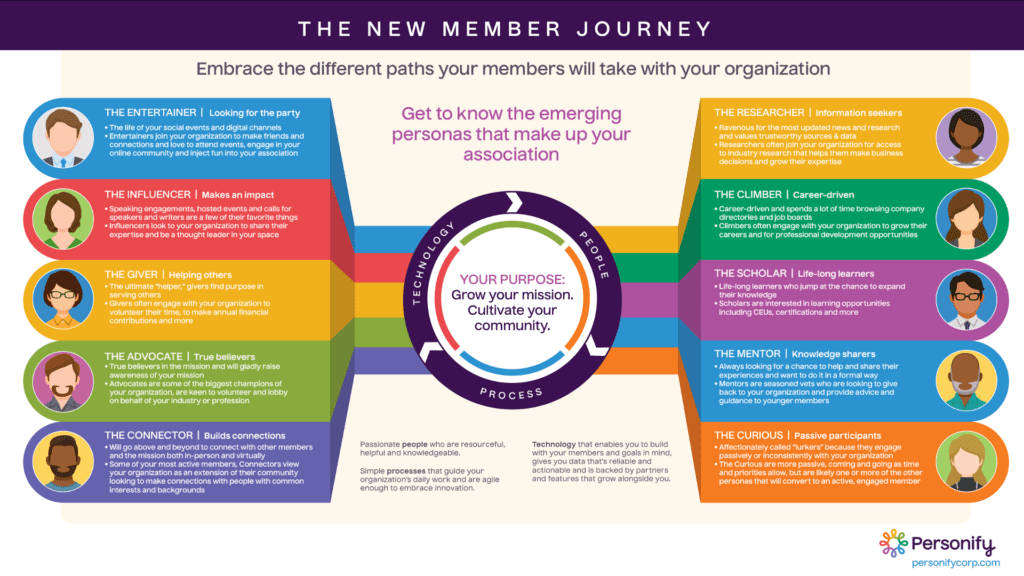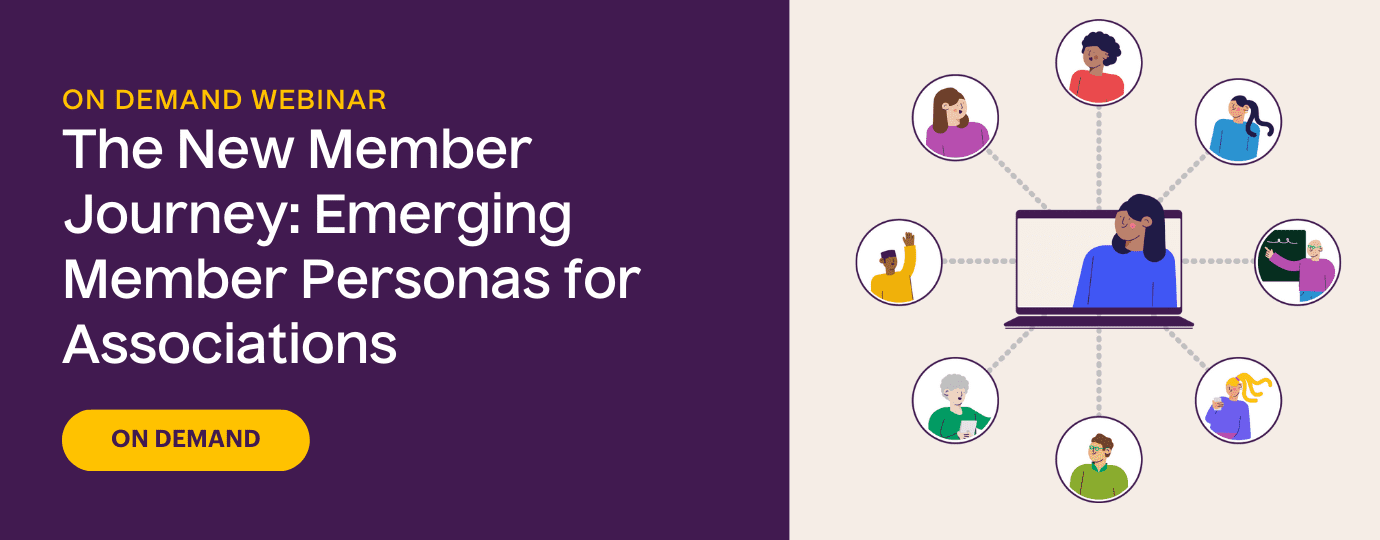Members are the core of your association. But are you, as association managers, giving them the ideal experience? Understanding their personas will help you craft experiences and dialogues that will resonate, building relationships and better member retention.
In a webinar hosted by Personify, leading industry experts explored these personas and their member journeys. Which experts you ask?
- Wes Trochlil, President of Effective Database Management
- Megan Woodburn, Founder and Co-CEO at Strategic Association Management
- Nick Ruffin, President and CEO of AMR Management Services
- Erin Sullivan, VP of Marketing at Personify
This blog recaps the highlights. You can watch the full discussion anytime, on-demand here.
What are member personas and why should you care?
A persona is a fictional representation of a person built on common traits. They’re used to help understand and predict user behaviors and empathetically speak to individuals you don’t know personally.
In the context of your members, the same use case applies. Understanding personas helps you build interactions that different individuals can relate to. Segment audiences and refine activities for each member’s journey with your association.
Below is a graphic of the 10 different personas that make up your association. Your members can be any combination of them. People join your association for a variety of reasons and their persona is a big part of why they join.

Example: The Advocate
An advocate will join because they’re passionate about the association’s mission. They want involvement and to help raise awareness. They’ll engage in activities such as fundraisers and volunteer opportunities. Their need is to fulfill their purpose as true believer, which is the core of the advocate persona.
Membership is no longer a one size fits all.
By embracing member personas, you’ll have happier members and boost engagement and retention.
What the experts say about member personas
How have you seen levels of engagement evolve or change in associations in recent years?
After the dramatic changes we saw after the 2020 pandemic, member engagement has evolved. Member expectations have shifted. Technology offers opportunities to run virtual events and build disparate communities online.
Nick Ruffin noted “the numbers we’ve seen of attendees for a virtual, annual conference is double or triple the numbers they had ever seen in person…it showed that there was this audience that was out there, that for whatever reason, just wasn’t going to come out to a conference.”
This demonstrates that there’s a persona of members who want to take part and engage. But, maybe just not in person.
We can give to all members, whether they prefer to engage in person or virtually. Megan Woodburn said it best, “how are we engaging the whole rather than just who has been our typical member or typical registrant at these events?”
“How are we engaging the whole rather than just who has been our typical member or typical registrant at these events?”
Megan Woodburn
Should evolving engagement trends change how associations run their business and programs? If so, how?
YES! We’ve acknowledged shifting member expectations. Wes Trochlil noted “members and customers are now saying you need to meet me on my terms and so how are you going to do that?”
Asking your members what’s working and what isn’t is a great way to boost engagement. Host a focus group, send out surveys and listen to your members when they give feedback.
Megan warns us to “be cautious about listening to only the loudest voices, make sure you’re doing this thoughtfully. Make sure you’re thinking about the whole rather than just solving one solution.”
“If the survey isn’t matching reality, then either we’re not asking the question right or they’re perceiving the question differently.”
Wes Trochlil
How can we better understand and serve people of all types and engagement levels in an association?
Nick Ruftin started this off by saying “there’s 1,000 ideas of things we can do, but we can’t afford to do all of them. You could maybe afford to do 2 or 3 of them well. Using the data of what your members actually want and participate in is where you should focus your energy on, in alignment with your strategic plan, mission and vision.”
Of course, this is easier said than done.
Wes drove this point home discussing situations where a segment of members seems to not care. They may always be members and have high retention. But they don’t interact, participate in surveys or volunteer. These members don’t engage in the same way you anticipated, but that’s okay. They’ll consume the content they want and participate in a level that works for them. Have your team encourage the engagement of these members and try to boost that engagement. Even if a member isn’t participating now, it doesn’t mean they won’t in the future.
“You’re not going to get all persona types to engage at a given time and space, and that’s okay.”
Nick Ruftin
The hybrid experience is something that has proven to engage all types of members. Erin Sullivan commented, “the post-pandemic member expects a hybrid experience and hybrid is expensive to put on…so you have to prioritize which events and programming make sense to provide a virtual component for, and which ones we want people to join in person.”
Given the past few years, how are you feeling about events and conferences in 2023?
Confidence in the events space is extremely high according to our panelists. It seems post-pandemic that people are craving in-person interaction. Megan spoke to this saying “events are back and they’re back strong. If fact we’re seeing about a 10% increase in attendance…a 60% increase in registration.”
“Events are back and they’re back strong. If fact we’re seeing about a 10% increase in attendance…a 60% increase in registration.”
Megan Woodburn
People belong to an association to meet with peers, network, learn and ask questions. Bringing back in-person events provides the perfect platform for all that to happen.
Which persona(s) do you identify most with?
Nick, being passionate but resistant to participation, identified as a combination of an advocate and curious.
Wes felt similar to Nick and is an influencer, giver and advocate.
Megan agreed that she is a combination of curious, advocate and influencer.
Erin identified strongly with the connector, as one of her strengths is winning others over and bringing people together.
All panelists felt their personas evolved over the course of their career. They identified with different personas in different career stages.
Looking at 2023, what opportunities and challenges do you foresee for associations?
Taking a hard look at your association is key here.
Is your association addressing member needs? Speaking their language and offering them relevant experiences will build strong relationships. You’ll ultimately build a stronger program with better retention.
The technology you use is critical. If you’re not evaluating it every couple of years you may be missing new opportunities.
Want to hear more? Learn how the American Society of Nutrition used their tech stack to pivot to online meetings and events during the pandemic.
A huge challenge our panelists identified was a possible recession. This will impact member travel budgets for events. It also speaks to agility and organizations staying nimble in the face of change.
Looking on the bright side, Nick noted, “this could be an opportunity for associations to network and create value for members. We all survived the 2008 recession, and we have way more resources, tools and technology now.”
Leverage your technology stack to understand your personas
A robust association management software (AMS) will allow you to segment member data. By evaluating demographics, preferences, job titles, event attendance and content engagement, you can better understand your association personas. Once you have an understanding you can craft programs and messages that resonate. Below are a few great technology options to help build engagement and programs for your many personas.
Learning Management System (LMS)
An LMS, like Classroom, engages your learning personas. You can provide opportunities to learn and gain certifications through Classroom. Bonus: this provides a good reason for employers to cover employee membership dues!
Members who benefit most from an LMS are:
- Researchers
- Climbers
- Scholars
An online community, like CommUnity, enables networking and community building. Members can engage and stay informed about your association’s programs. A community is a great way to connect people on specific topics or in geographic areas. You can go as big or as small as you want and let them lead the conversation.
We’ve heard a lot of success in online communities connecting members in disparate locations – or globally. Or for onboarding young members. If your community syncs with your Association Management Software, even better. This creates more data points you can lean into to work with those personas.
Members who benefit most from online communities are:
- Entertainers
- Influencers
- Givers
- Advocates
- Connectors
- Mentors
A job board, like Personify’s Job Board, enables members to post and search for jobs. They can also learn about volunteer and research positions. This is great for those seeking career path growth or to grow their association or business.
Members who benefit most from a job board are:
- Climbers
- Advocates
- Scholars
- Researchers
An event management tool (we have a lot of those at Personify) will help you create events members will love. Connect people virtually and face-to-face for professional development, networking, friendship and more.
Members who benefit most from events are:
- Influencers
- Advocates
- Connectors
To watch the full conversation between Megan, Nick, Wes and Erin click the link below!
